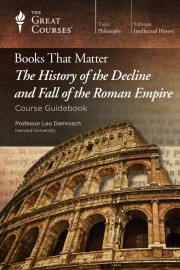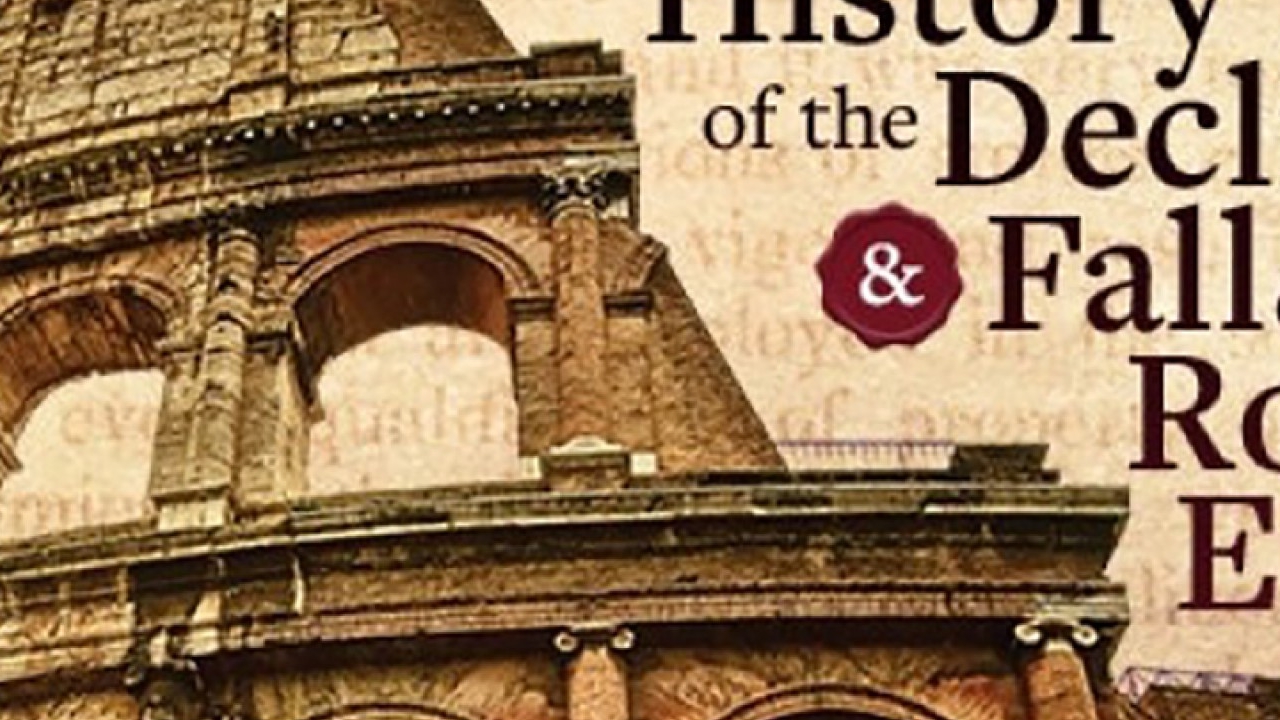Filter by Source
Seasons

24. Decline and Fall in Modern Perspective
Professor Damrosch ends his course with a reflections on the Decline and Fall in the 21st century. You'll consider why some historians reject the term "fall" in favor of "transformation," together with insistence by recent specialists that there truly was a fall; and also three major blind spots Gibbon exhibits in his history: toward religion, toward Byzantine civilization, and toward the persistence of deep cultural rhythms as contrasted with political and military events.

23. The End of Gibbon's Work
How did Gibbon keep the Decline and Fall from simply petering out in its final chapter?What were some of his assumptions about the "darkness and confusion" of medieval Europe? See how his visit to the physical ruins of Rome inspired Gibbon's final thoughts on the collapse of the empire and helped to bring his great work to a close.

22. The Fall of Constantinople
Chapters 66 to 70 chronicle the final defeat of Byzantium. Topics you'll explore in this lecture include the exiled papal court at Avignon, Mahomet the Second's capture of Constantinople, and the Great Schism from 1378 to 1417.

21. Genghis Khan and Tamerlane
Unpack another turning point in the Decline and Fall: Genghis Khan and the dawn of the Ottoman Empire. Central to this lecture is another of Gibbon's charismatic figures: Tamerlane (known as "the scourge of God"). Then, end with Gibbon's account of the discovery of gunpowder-which would forever change history.

20. The Crusades
Gibbon's account of the Crusades focused on the way religion was used to rationalize European military and territorial aggression. Learn what this master historian has to say about the rivalry of Richard the Lionheart and Saladin, the birth of the Crusader States, and military orders like the Knights Templar.

19. The Byzantine Empire in the 10th Century
At the end of the Decline and Fall's fifth volume, you'll survey the ever-shrinking form of the Byzantine Empire (Chapter 53), early Russians (Chapter 55), Norman conquests in the Mediterranean (Chapter 56), and the expanding dominion of the Turks (Chapter 57).

18. The Rise of Islam
Step back in time to get Gibbon's account of the rise of Islam. Occupying Chapters 50 to 52, this narrative emphasizes how, in Gibbon's view, Islam arrived at a fortunate historical moment when it faced only weak opposition from surrounding powers; he also pays warm tribute to Muhammad's qualities of character.

17. The Byzantine Empire and Charlemagne
Turn now to the fifth volume (of the original six) of the Decline and Fall, where the narrative starts to speed up. In addition to covering historical moments like the reign of Charlemagne and the Comnenian dynasty, you'll also consider the implications of Gibbon's "great man" approach to history from the 7th to 11th centuries.

16. The Breakup of the Empire
After the fall of the empire in the West, how did Byzantium in the East persist for another nine centuries? Start with this look at Chapters 45 to 47, which cover the consolidation of France under Clovis, the establishment of the papacy as the center of Christendom, and a new swarm of religious heresies.

15. Theodoric and Justinian
The first was a Gothic king; the second Rome's eastern emperor. Theodoric and Justinian (along with his general, Belisarius, and his wife, Theodora) dominate Chapters 39 to 44 of the Decline and Fall, which also examines Constantinople's massive building program (including the Hagia Sophia) and the codification of Roman Law.

14. Huns and Vandals
Professor Damrosch guides you through successive waves of barbarian invaders, beginning with the assault of the Huns, led by Attila. You'll also get Gibbon's insights on the development of barbarian kingdoms, a sequence of nine Roman emperors in just 20 years, and his biased views on the growth of monasticism.

13. East and West Divided
With Rome's fracture into eastern and western camps, the story of the empire's decline begins to get complicated. Learn how to navigate the tricky waters of Chapters 29 to 33, which examine cataclysmic events including the sack of Rome in 410 A.D. and the loss of North Africa to the Vandals.

12. Barbarian Advances and Theodosius
In the wake of Julian's death there was great confusion, which occupies Chapters 25 to 28. Topics covered here include increased barbarian threats from in Britain, Germany, the Middle East, the Danube, and North Africa; the "chaste and temperate" rule of Theodosius; and Gibbon's intriguing thoughts on Christian veneration of saints' relics.

11. Julian and the Return to Paganism
Paganism in the Empire didn't go down without a fight. Enter Julian the Apostate, who tried to reinstate the Olympian gods. Here, study Chapters 22 to 24, which are devoted to this last dying gasp of paganism-struck down by Julian's death during an ill-advised military campaign, and afterward by pushback from the Christians.

10. Constantine and Athanasius
Chapter 17 is the major turning point in the Decline and Fall. What are Gibbon's thoughts on the transferring of the capital to Constantinople, and on Constantine's famous vision of the cross? Why does he give so much attention to theological controversies, and why was he so impressed by Athanasius, the archbishop of Alexandria?

9. The Rise of Christianity
Continue your look at Chapters 14 and 15 of the Decline and Fall. In these pages, Gibbon takes up five causes for Christianity's success, including proselytizing zeal the promise of a future life in heaven, but also unprecedented organizational ability. What Gibbon leaves out, however: any imaginative empathy with religion.

8. Enlightenment Skepticism
Consider just how dangerous Gibbon's sociological treatment of Christianity in Chapters 14 and 15 (while grounding the faith in extremely detailed historical analysis) seemed to most of his readers. Rather than focusing on divine providence, the Decline and Fall documents the human causes behind Christianity's evolution into the dominant ideology of the ancient world.

7. Diocletian and the Triumph of Constantine
Get a close reading of Chapters 8 to 14 of Gibbon's masterpiece. In these pages, follow the first assaults of the barbarians who would eventually bring the Empire to its knees: the Goths. Also, meet two emperors who would radically reshape the structure of the Roman Empire: Diocletian and Constantine.

6. The Hidden Poison Begins to Work
After the peace of the Antonines, things quickly began to fall apart. Describing the horrific reigns of emperors like Commodus, Caracalla, and Elagabalus, Gibbon illustrates the "hidden poison" by which one-man rule produced a vicious cycle of incompetent, power-corrupt emperors.

5. The Golden Age of the Antonines
Meet the Antonines: the subject of the first three chapters of the Decline and Fall. From Nerva to Hadrian to Marcus Aurelius, these "five good emperors" ruled the only period of history in which the happiness of a great people was the sole object of government.

4. The Theory and Practice of History
It's no accident that the Decline and Fall survives as a great work of history. Here, explore how Gibbon understood the role of the historian; consider what he thought of Hume, Voltaire, and other Enlightenment writers; and discover how he revolutionized the use of extensive documentation in his work.

3. The Empire at Its Beginning
Before plunging into the Decline and Fall, which starts in the second century A.D., you need a little background in early Roman history. Professor Damrosch reviews the Empire's important provinces (including their strange names), the excessive influence of the Roman military, the emergence of imperial dictatorship, and other facts Gibbon's original readers took for granted.

2. The Making of Gibbon the Historian
Follow Edward Gibbon's intellectual development: his childhood obsession with reading, his military service, his disappointed love, his social circles, his personal politics, and his life as a gentleman "scholar of leisure." Your primary source for this biographical study: fragments from Gibbon's posthumously published Memoirs.

1. The Greatness of Gibbon's Decline and Fall
Ground your understanding of Gibbon's masterpiece with this helpful introductory lecture. Why was Rome so important to Gibbon and his readers? What makes the periodic style so essential to the Decline and Fall's accessibility? Why should we want to read it today in the 21st century?
Description
Where to Watch Books that Matter: The History of the Decline and Fall of the Roman Empire
Books that Matter: The History of the Decline and Fall of the Roman Empire is available for streaming on the website, both individual episodes and full seasons. You can also watch Books that Matter: The History of the Decline and Fall of the Roman Empire on demand at Prime Video and Amazon.
-
Genres
-
Premiere DateMarch 2, 2017























